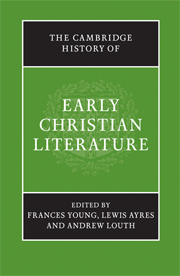Book contents
- Frontmatter
- PART ONE The Beginnings: The New Testament to Irenaeus
- PART TWO THE THIRD CENTURY
- PART THREE FOUNDATION OF A NEW CULTURE: FROM DIOCLETIAN TO CYRIL
- A LITERARY GUIDE
- 21 Classical genres in Christian guise; Christian genres in classical guise
- 22 Arnobius and Lactantius
- 23 Eusebius and the birth of church history
- 24 The fourth-century Alexandrians: Athanasius and Didymus
- 25 Palestine: Cyril of Jerusalem and Epiphanius
- 26 The Cappadocians
- 27 Fourth-century Latin writers: Hilary, Victorinus, Ambrosiaster, Ambrose
- 28 Jerome and Rufinus
- 29 Augustine
- 30 John Chrysostom and the Antiochene School to Theodoret of Cyrrhus
- 31 Cyril of Alexandria
- 32 Hagiography
- 33 Ephrem and the Syriac Tradition
- 34 The literature of the monastic movement
- 35 Women and words: texts by and about women
- 36 Conciliar records and canons
- B CONTEXT AND INTERPRETATION
- Bibliographies
- Index
- Map: The Roman Empire in the late fourth century AD"
- References
33 - Ephrem and the Syriac Tradition
from A - LITERARY GUIDE
Published online by Cambridge University Press: 28 March 2008
- Frontmatter
- PART ONE The Beginnings: The New Testament to Irenaeus
- PART TWO THE THIRD CENTURY
- PART THREE FOUNDATION OF A NEW CULTURE: FROM DIOCLETIAN TO CYRIL
- A LITERARY GUIDE
- 21 Classical genres in Christian guise; Christian genres in classical guise
- 22 Arnobius and Lactantius
- 23 Eusebius and the birth of church history
- 24 The fourth-century Alexandrians: Athanasius and Didymus
- 25 Palestine: Cyril of Jerusalem and Epiphanius
- 26 The Cappadocians
- 27 Fourth-century Latin writers: Hilary, Victorinus, Ambrosiaster, Ambrose
- 28 Jerome and Rufinus
- 29 Augustine
- 30 John Chrysostom and the Antiochene School to Theodoret of Cyrrhus
- 31 Cyril of Alexandria
- 32 Hagiography
- 33 Ephrem and the Syriac Tradition
- 34 The literature of the monastic movement
- 35 Women and words: texts by and about women
- 36 Conciliar records and canons
- B CONTEXT AND INTERPRETATION
- Bibliographies
- Index
- Map: The Roman Empire in the late fourth century AD"
- References
Summary
Virtually every aspect of Syriac Christianity prior to the fourth century remains obscure, and it is only then that one can feel oneself on firmer ground. This is due not only to the presence of more and better historical sources, but also to the fact that three major bodies of writing in Syriac survive from this century: Aphrahat’s twenty-three Demonstrations, Ephrem’s extensive writings in both prose and (above all) poetry, and the anonymous guide to the spiritual life entitled The Book of Steps. The first and third of these were produced within the Sasanian Empire, while Ephrem was writing in the easternmost area of the Roman Empire, first in Nisibis, and then in Edessa. Together, these writings provide us with the best evidence we have for the character of Syriac literary culture at a period when it was still comparatively unhellenized.
Aphrahat ‘the Persian Sage’ was also known at an early date under the name of Jacob, which soon led to confusion with Jacob, bishop of Nisibis, who died in 338. Aphrahat, however, was definitely writing within the Sasanian Empire, and furthermore his works are exactly dated, for Demonstrations 1–10 are given the date 337, while 11–22 belong to 344, and 23 to August 345 (1–22 provide an alphabetic acrostic). The title ‘Demonstration’ happens to correspond exactly to the Greek επιδειζις, but it is unlikely that the Greek genre has had any direct influence on Aphrahat’s writing; he himself also describes his short treatises on occasion as ‘Letters’.
- Type
- Chapter
- Information
- The Cambridge History of Early Christian Literature , pp. 362 - 372Publisher: Cambridge University PressPrint publication year: 2004
References
- 1
- Cited by



